Current Affairs 05 October 2023
Today’s News
Seven dead as glacial lake bursts in Sikkim
(Current Affairs 05 October 2023 | Relevant for GS Paper-3, Disaster and disaster management)

- At least seven people were killed and scores more were injured or are missing after flash floods inundated Sikkim.
- The floods are believed to have been triggered after a lake, forming from the gradual melting of a Himalayan glacier, suddenly overflowed and inundated the Teesta river basin.
- This destroyed the Chungthang dam, a key component of the State’s largest hydroelectric project, and washed away highways, villages, and towns.
- The worst affected districts were Mangan, Gangtok, Pakyong, and Namchi. Twentytwo Army personnel were among those reported missing.
Refresh basics
Glacial lake outburst flood (GLOF)
- A glacial lake outburst flood (GLOF) is a type of catastrophic flood that occurs when the dam containing a glacial lake fails, releasing a large volume of water. This type of flood is typically caused by rapid melting of glaciers or the buildup of water in the lake due to heavy precipitation or the inflow of meltwater.
- In February 2021, Chamoli district in Uttarakhand witnessed flash floods which are suspected to have been caused by GLOFs.
Causes:
- These floods can be triggered by a number of factors, including changes in the volume of the glacier, changes in the water level of the lake, and earthquakes.
- According to NDMA (National Disaster Management Authority), glacial retreat due to climate change occurring in most parts of the Hindu Kush Himalayas has given rise to the formation of numerous new glacial lakes, which are the major cause of GLOFs.
NDMA’s Guidelines to Tackle Glacial Burst
Identifying Potentially Dangerous Lakes:
Potentially dangerous lakes can be identified based on field observations, records of past events, geomorphologic and geotechnical characteristics of the lake/dam and surroundings, and other physical conditions.
Use of Technology:
Promoting use of Synthetic-Aperture Radar imagery (a form of radar that is used to create two-dimensional images) to automatically detect changes in water bodies, including new lake formations, during the monsoon months.
Channeling Potential Floods:
Reducing the volume of water with methods such as controlled breaching, pumping or siphoning out water, and making a tunnel through the moraine barrier or under an ice dam.
Uniform Codes for Construction Activity:
- Developing a broad framework for infrastructure development, construction and excavation in vulnerable zones.
- There is a need to accept procedures for land use planning in the GLOF prone areas.
Enhancing Early Warning Systems (EWS):
- The number of implemented and operational GLOF EWS is very small, even at the global scale.
- In the Himalayan region, there are at least three reported instances (two in Nepal and one in China) of implementation of sensor- and monitoring-based technical systems for GLOF early warning.
Training Local Manpower:
- Apart from pressing specialised forces such as National Disaster Response Force (NDRF), ITBP and the Army, NDMA has emphasised the need for trained local manpower.
- It has been observed that over 80% of search and rescue is carried out by the local community before the intervention of the state machinery and specialised search and rescue teams.
Comprehensive Alarm Systems:
Besides classical alarm infrastructure consisting of acoustic alarms by sirens, modern communication technology using cell and smartphones can complement or even replace traditional alarming infrastructure.
Trio wins Chemistry Nobel for ‘quantum dots’
(Current Affairs 05 October 2023 | Relevant for Prelims, Science and Technology)
- The 2023 Nobel Prize in Chemistry has been awarded to Alexei Ekimov, Louis Brus, and Moungi Bawendi for their work on quantum dots — very small crystals with peculiar properties that have found application in a variety of fields, from new age LED screens to quantum computers.
- Earlier, reports emerged that the Nobel Committee had inadvertently revealed the names of the winners in an email, accessed by the Swedish press, in an unusual break from a tradition in which the identity of the laureates remains a closely guarded secret until the announcement.
Refresh basics
Quantum dots
- These are man-made nano scale crystals that that can transport electrons.
- When UV light hits these semiconducting nanoparticles, they can emit light of various colors.
- These artificial semiconductor nanoparticles that have found applications in composites, solar cells and fluorescent biological labels.
Women’s quota, panchayats to Parliament
(Current Affairs 05 October 2023 |Relevant for GS paper-2,devolution of powers and finances to the local level and challanges there in, GS paper-1, women and related issues)
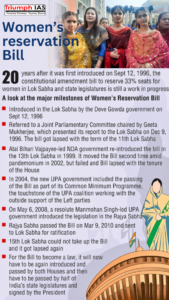
- The landmark Women’s Reservation Bill — now the Constitution (106th Amendment) Act — that reserves onethird of the total seats in the Lok Sabha and State Legislative Assemblies for women received presidential assent recently.
- As the first law passed in the new Parliament building during a special session, it portends a new chapter in India’s democratic journey.
- It comes on the 30th anniversary of the constitutional reforms that reserved one third of seats in panchayats and municipalities for women. Since then, there have been multiple unsuccessful attempts to extend women’s reservation to the Lok Sabha and State Assemblies.
- Parliament, 30 years ago, enacted the 73rd and 74th Constitutional Amendments that sought to make panchayats and municipalities “institutions of self government”. It mandated a minimum of one third of seats and office of chairpersons in panchayats and municipalities to be reserved for women.
- It also mandated reservation for Scheduled Castes (SCs) and Schedules Tribes (STs) based on their percentage population and enabled States to reserve seats for Backward Classes. This has created a system with over 3 million elected panchayat representatives, out of which almost half are women.
- The expansion and diversification of the representative base of Indian democracy is the most successful element of these constitutional reforms.
- While the Union government’s 2009 constitutional amendment to increase women’s reservation in local governments from 33% to 50% failed, many States have enacted laws that reserve 50% seats for women and also instituted reservations of seats for Other Backward Classes (OBCs).
- Such a mix of vertical and horizontal reservations recognises the aggravated disadvantage people face due to their location in the intersection of their caste and gender identities.
- However, unlike the case of the 73rd and 74th amendments, the present law does not enable reservation for OBC women.
- Beyond representation, has women’s reservation in local governments yielded substantive benefits? A 2004 paper by Esther Duflo and Raghabendra Chattopadhyay on panchayats in West Bengal and Rajasthan found that women leaders invest more in public goods and ensure increased women’s participation in panchayat meetings.
- Evidently, the impact of women’s reservation is not straightforward. The design of women’s reservations in Parliament and State Assemblies should have ideally been informed by its 30year experience in panchayats and municipalities.
- Since the role that women play in local governments is different from their role in Parliament, the impact of reservation may play out differently.
- Unlike the 2008 version, the present women’s reservation law has tied its implementation with the conduct of delimitation and census, neither of which have a definite date.
Retribution for the south, accolade for the north
(Current Affairs 05 October 2023 | Relevant for GS Paper-2, Federalism)

- In Indian federal democracy, a State’s relative population size gains political and economic significance. The strong linguistic identities and regional renaissances in political and social spheres propelled the southern States to scale greater heights in all spheres of development.
- Article 81 of the Indian Constitution stipulates that Lok Sabha constituencies in the country should be equal by the size of population. Based on the 1971 Census, the number of Lok Sabha constituencies for States was determined and frozen for the next 25 years through the 42nd Amendment Act 1976.
- The population growth rates differ between the non Hindi speaking southern States and the Hindispeaking northern States. Between 1971 and 2011, the proportion of the population of Bihar, Chhattisgarh, Gujarat, Jharkhand, Madhya Pradesh, Rajasthan, Uttarakhand and Uttar Pradesh increased from 44% to 48.2%, whereas the proportion of population of the five southern States (Andhra Pradesh, Karnataka, Kerala, Tamil Nadu, Telangana) declined from 24.9% to 21.1%.
- The problem of balancing the political representation of subcentral units that have lower populations arises in all federations. For instance, Canada has been consistently increasing the proportion of representation in the national Parliament for the less populous provinces.
- In a ‘First Past the Post’ election system, along with a multiparty contest, voters know that only one of the contestants shall win, that is, the winner takes all. Often, winners are elected even with less than one third of the votes polled. If we calculate the proportion of votes secured by the winner in a constituency, it may be less than one fifth of registered voters or even one sixth of the total population of the constituency.

- In a ‘First Past the Post’ election system, along with a multiparty contest, voters know that only one of the contestants shall win, that is, the winner takes all. Often, winners are elected even with less than one third of the votes polled. If we calculate the proportion of votes secured by the winner in a constituency, it may be less than one fifth of registered voters or even one sixth of the total population of the constituency.
- When family planning and population control are the stated policies of the national and regional governments in India, States that have implemented these policies and effectively controlled their population should not be penalised through reduced political representation in subsequent periods.
- Population control happens not only due to the implementation of family planning programmes but also because of the social change that is engineered by the leaders in the society. Population control in the southern States is a classic example of this feat.
- Once in five years the Union government constitutes a Finance Commission to recommend, among other things, the share of each State in the assigned tax revenue of the Union government.
- Population of a State is a measure of demand for public expenditure. Therefore, it is an important variable in the distribution formula. The first Finance Commission decided a State’s share based on its population size. The successive Finance Commissions reduced the weight assigned to the population in the distribution formula while including other variables.
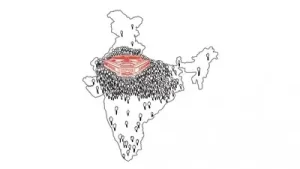
- The Union government, in its terms of reference to the Eighth Finance Commission (1984-89), stipulated to use only the 1971 population in the distribution instead of the 1981 population. This practice continued thereafter till the Thirteenth Finance Commission (2010-15).
- In terms of reference for the Fourteenth Finance Commission, the Union government stipulated that apart from taking the 1971 population, the Commission may also consider demographic changes since 1971, wherever the population is to be used.
- There is another factor that consistently brings in the current population in the distribution formula — the per capita income of a State. The per capita income of a State is considered as a proxy for its ability to raise its own revenue.
- The higher the per capita income of a State, the lower its share in the Union tax revenue. Lower per capita income of a State may be due to higher population for a given Gross State Domestic Product. Therefore, the higher the current population of a State, the higher its share in the Union tax revenue.
- Using the current population for delimitation of Lok Sabha constituencies by equalizing population and in the distribution formula for assignment of Union government tax revenue to States is clear retribution for the population control efforts of the southern States and a transparent accolade for the higher growth rate of population in the northern States.
New defence indigenisation list has futuristic weapons, systems
(Current Affairs 05 October 2023 | Relevant for Prelims, GS paper-3, Security challanges and their manangement in border areas)
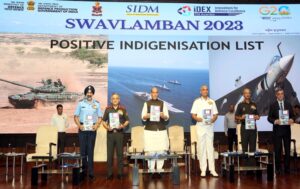
- Defence Minister Rajnath Singh on Wednesday released the fifth Positive Indigenisation List of 98 items to be procured by the three Services from domestic sources in a staggered manner on specified timelines.
- The Department of Military Affairs compiled the list after several rounds of consultations with all stakeholders, the Defence Ministry said in a statement.
Refresh basics
Indigenisation of Defence
- Indigenisation is the capability of developing and producing any defence equipment within the country for the dual purpose of achieving self reliance and reducing the burden of imports.
- Self-reliance in defence manufacturing is one of the key objectives of Department of Defence Production.
- Defence Research Development Organisation (DRDO), Defence Public Sector Undertakings (DPSUs), Ordnance Factory Board (OFB) and private organisations are playing a critical role in indigenisation of defence industries.
SAMPRITI- XI Exercise 2023
(Current Affairs 05 October 2023 |Relevant for Prelims)
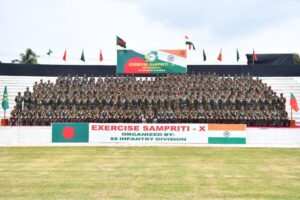
- The 11th edition of the annual joint military exercise, SAMPRITI, commenced on 3rd October 2023, in Umroi, Meghalaya. This exercise, organized alternately by India and Bangladesh, highlights the strong bilateral defence cooperation between the two countries.
- SAMPRITI-XI is a 14-day exercise that aims to enhance interoperability between the two armies, share tactical drills, and promote best practices.
- The exercise will include a Command Post Exercise (CPX) and a Field Training Exercise (FTX), focusing on Sub-Conventional Operations as per Chapter VII of the United Nations Charter, it gives the UN Security Council the power to maintain peace.
- The CPX will emphasize decision-making after thorough deliberations.
- The FTX will validate grassroots-level operations through joint tactical drills for counter-terrorist operations, including hostage rescue, crowd control measures, and the use of helicopters.
- The two nations also conduct Naval Exercise Bongosagar.
Related Blogs…
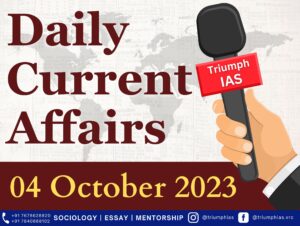 |
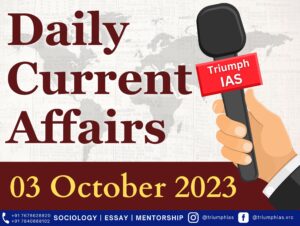 |
GS Related Practices Question…
To master these intricacies and fare well in the Sociology Optional Syllabus, aspiring sociologists might benefit from guidance by the Best Sociology Optional Teacher and participation in the Best Sociology Optional Coaching. These avenues provide comprehensive assistance, ensuring a solid understanding of sociology’s diverse methodologies and techniques.
META TAGS:
Current affairs 05 October 2023, Current affairs 04 October 2023, Today news, Today news GS, Today news upsc, Today news and views, Today news 2023, Today news Current affairs September 2023, Current affairs news, Current affairs book pdf, Current affairs best blog, Current affairs for UPSC, Current affairs 2023, Current affairs contact, Current affairs book, Current affairs program meaning

Choose The Best Sociology Optional Teacher for IAS Preparation?
At the beginning of the journey for Civil Services Examination preparation, many students face a pivotal decision – selecting their optional subject. Questions such as “which optional subject is the best?” and “which optional subject is the most scoring?” frequently come to mind. Choosing the right optional subject, like choosing the best sociology optional teacher, is a subjective yet vital step that requires a thoughtful decision based on facts. A misstep in this crucial decision can indeed prove disastrous.
Ever since the exam pattern was revamped in 2013, the UPSC has eliminated the need for a second optional subject. Now, candidates have to choose only one optional subject for the UPSC Mains, which has two papers of 250 marks each. One of the compelling choices for many has been the sociology optional. However, it’s strongly advised to decide on your optional subject for mains well ahead of time to get sufficient time to complete the syllabus. After all, most students score similarly in General Studies Papers; it’s the score in the optional subject & essay that contributes significantly to the final selection.
“A sound strategy does not rely solely on the popular
Opinion of toppers or famous YouTubers cum teachers.”
It requires understanding one’s ability, interest, and the relevance of the subject, not just for the exam but also for life in general. Hence, when selecting the best sociology teacher, one must consider the usefulness of sociology optional coaching in General Studies, Essay, and Personality Test.
The choice of the optional subject should be based on objective criteria, such as the nature, scope, and size of the syllabus, uniformity and stability in the question pattern, relevance of the syllabic content in daily life in society, and the availability of study material and guidance. For example, choosing the best sociology optional coaching can ensure access to top-quality study materials and experienced teachers. Always remember, the approach of the UPSC optional subject differs from your academic studies of subjects. Therefore, before settling for sociology optional, you need to analyze the syllabus, previous years’ pattern, subject requirements (be it ideal, visionary, numerical, conceptual theoretical), and your comfort level with the subject.
This decision marks a critical point in your UPSC – CSE journey, potentially determining your success in a career in IAS/Civil Services. Therefore, it’s crucial to choose wisely, whether it’s the optional subject or the best sociology optional teacher. Always base your decision on accurate facts, and never let your emotional biases guide your choices. After all, the search for the best sociology optional coaching is about finding the perfect fit for your unique academic needs and aspirations.
To master these intricacies and fare well in the Sociology Optional Syllabus, aspiring sociologists might benefit from guidance by the Best Sociology Optional Teacher and participation in the Best Sociology Optional Coaching. These avenues provide comprehensive assistance, ensuring a solid understanding of sociology’s diverse methodologies and techniques. Sociology, Social theory, Best Sociology Optional Teacher, Best Sociology Optional Coaching, Sociology Optional Syllabus.
Best Sociology Optional Teacher, Sociology Syllabus, Sociology Optional, Sociology Optional Coaching, Best Sociology Optional Coaching, Best Sociology Teacher, Sociology Course, Sociology Teacher, Sociology Foundation, Sociology Foundation Course, Sociology Optional UPSC, Sociology for IAS,
Follow us :



Find More Blogs…
| Compare and contrast Karl Marx’s and Max weber’s | Karl Marx- Historical Materialism |
| Talcott Parsons : Social system | Scope of the subject and comparison with other social sciences |

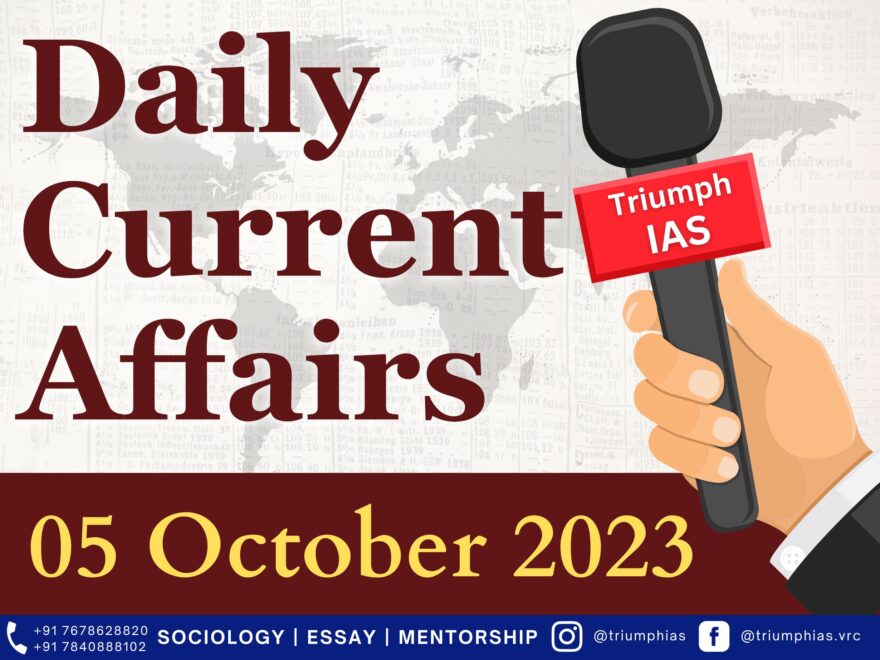

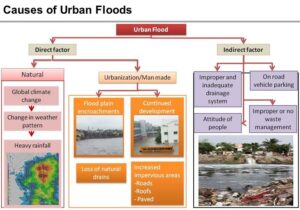
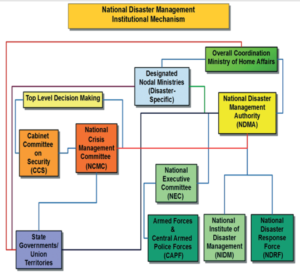




2 comments